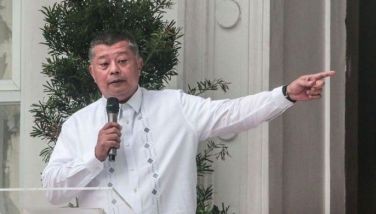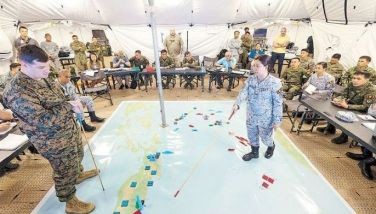Women of Siargao's Sugba Lagoon take charge in tourism recovery of the island
DEL CARMEN, Surigao del Norte — From the main island of Siargao in the town of Del Carmen, one takes a brief boat ride across the relatively calm sea and pierces the light fog that conceals the entrance to turquoise waters stilled by rock formations where foliage has grown lush.
As the vessel approaches the boardwalk, its engine stops whirring and boatmen begin rowing to reach the dock where a lady will cheerfully greet: “Good morning! Welcome to Sugba Lagoon!”
At Sugba Lagoon, marketed by the local government as a “stress-free place … away from the noisy city," women run the tourist attraction.
They are part of the 131-member Barangay Caub Marine Association (Bacama), a people’s organization composed mostly of fishermen’s wives dedicated to overseeing the tourist sites within the village, particularly Sugba Lagoon.
Throughout the week, members of the association take turns in staffing the hut at Sugba Lagoon where tourists can rent tables, paddleboards and kayaks. Fees collected are split in half among those on duty and the organization, which it uses for repairs.
As tourists slowly return to Siargao after the easing of pandemic restrictions and the onslaught of Super Typhoon Odette, Bacama members like Jelly Calayag have started earning around P300 to P500 each daily, which they use to augment the income of their husbands from fishing.
“At least we helped our husbands buy rice or helped give our children pocket money as they studied in college,” Calayag said in Filipino.
Surviving the ‘end of the world’
Barangay Caub was one of the worst hit areas in Siargao by Odette as the typhoon practically wiped out the whole village, including a two-storey building at Sugba Lagoon.
“Our barangay was totally damaged. No house was left standing. All of it collapsed. What was hard then was that we didn't have anything to drink, we didn't have anything to eat, we didn't have anything to clothe ourselves. We just cried. We thought it was the end of the world,” Calayag said.
Remnants of the destruction left by Odette remain in the area. Particularly in Sugba Lagoon, some felled trees can still be seen on the rock formations, although vegetation has turned these green again. In place of the destroyed two-storey building is a hut that temporarily caters to tourists.
Barangay Caub captain Raquel Barquilla credited their swift recovery to government and private sector aid .
“I’m happy and grateful because a lot of people helped us,” Barquilla said in Filipino. “We didn't struggle in recovery because in the following months, a lot of relief goods came in to the extent that even boats and houses were repaired.”
Part of the assistance that locals in Barangay Caub and other areas in Siargao received after Odette was the Department of Labor and Employment’s cash for work program in partnership with the United States Agency for International Development.
Some 500 people across five towns benefitted from the program where they earned P340 per day for 10 days in exchange for finding and replanting seedlings of trees and mangroves.
“It was a big help for us as the people did not lose hope because they saw a lot of people were helping. So many people helped,” Barquilla said.
Hope for the future
Now that visitors are trickling in and their income is similar to before the pandemic and Odette hit, the women of Sugba Lagoon hope that their recovery will continue.
Particularly, they wish that more assistance would come in so they can sell souvenirs and finally rebuild the two-storey structure for tourists, which they have secured funding for from the Tourism Infrastructure and Enterprise Zone Authority.
Barangay Caub is also looking at opening another tourist spot near Sugba Lagoon to ease congestion there.
In 2018, upon the direction of Del Carmen Mayor Alfredo Coro II, barangay officials discovered a cave that boasts of formations that sparkle under the light.
The Caub Crystal Cave, as called by the local government, is just awaiting for further clearance from environment officials before it is opened to the public which Barquilla hopes would further supplement the income of the women in her village.
“Barangay Caub depends on fishing, on the sea. We don’t have fields or gardens which we could tap as alternatives to fishing, so it’s really important for us to augment their income because for example, the weather is bad, only the women in Sugba Lagoon earn,” she said.
--
Disclosure: This story was made possible through the support of USAID's Sustainable Interventions for Biodiversity, Oceans, and Landscapes (SIBOL), which arranged transportation and accommodations for the Philstar.com reporting team. This article was produced following editorial guidelines and USAID’s SIBOL did not have input on how the story would be written.
- Latest
- Trending




























